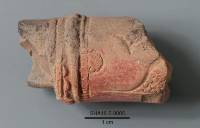The Iron Age occupation
An Iron Age pot burial was recorded at the base of the mound, where the winterly high water of the lake had washed out the jar of an infant burial in 2012. Should the regional Iron Age burial customs be comparable to Mesopotamian burial customs of that time, it would appear likely that the burial had originally been located below the floor of a domestic structure. However, due to their position close to the modern surface of the mound, the Iron Age remains are especially endangered by erosion processes caused by the Darand-i Khan lake. For example, the Iron Age remains in the area around the pot burial had already been washed away in 2016, when Sector 4 was opened in this part of the mound.
Further Iron Age remains were uncovered during the 2017 season on the northwestern slope of the main mound in Sector 6. Under modern debris of the old village remnants of mud-brick and stone architecture were excavated. They were severely eroded by the waters of the lake, but they nevertheless indicate that in the future Iron Age remains may be investigated on a larger scale in this part of the main mound.
Remains of later periods
The youngest remains at Gird-i Shamlu belong to the Kurdish village, which carried the same name as the mound. It was abandoned when the Darband-i Khan lake was built in the early 1960s. However, the waters of the lake have erased the remains of the village almost completely. Only the graves of the villagers on the top of the main mound as well as some poorly preserved structures in Sector 6 on the northwestern slope of the main mound are left.
Ottoman remains of the 18th century show some open- air activities on the shallow mound to the east of the main mound. A tannur- oven was cut into Early Bronze Age contexts. Furthermore, some ditches were recorded, but no architectural remains. These remains may have been connected to the medieval cemetery that has been recognized beneath the modern graveyard on top of the main mound.
It should also be mentioned that sherds of Sasanian and Parthian pottery and glass vessels were found in mixed, loose topsoil debris on the main mound. However, they cannot be associated with any architectural remains yet.


